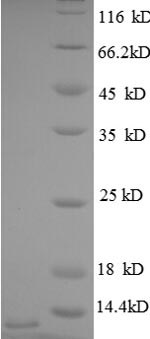Dive deeper into immunology research with our high-quality Recombinant Human CXCL3 protein. As a member of the C-X-C motif chemokine family, CXCL3 (also known as GRO3, GROG, or SCYB3) plays a significant role in the recruitment and activation of leukocytes, contributing to inflammation and immune response processes.
Our recombinant protein represents the full length of the mature human CXCL3, including the 35-107aa expression region. Expertly produced in E.coli, the protein features an N-terminal 6xHis-tag for simplified purification and detection. Boasting a purity greater than 90% as determined by SDS-PAGE, our Recombinant Human CXCL3 ensures a reliable product for your immunology investigations. Available in both liquid and lyophilized powder forms, this protein offers flexibility for your experimental requirements.




